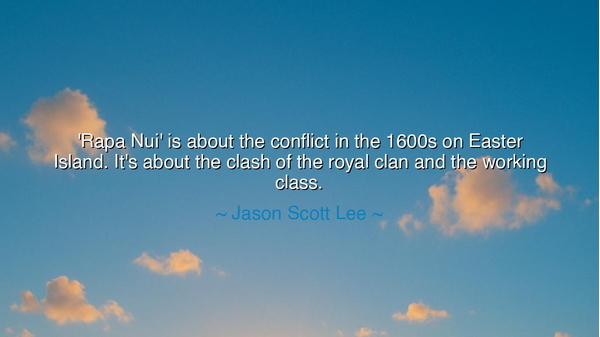
'Rapa Nui' is about the conflict in the 1600s on Easter Island.
'Rapa Nui' is about the conflict in the 1600s on Easter Island. It's about the clash of the royal clan and the working class.






The words of Jason Scott Lee—“‘Rapa Nui’ is about the conflict in the 1600s on Easter Island. It's about the clash of the royal clan and the working class”—open a window into one of the most profound and tragic tales of human civilization. Beneath his brief summary lies the eternal story of power, pride, and survival, one that has echoed across empires, kingdoms, and tribes since the dawn of time. In his reflection on the film Rapa Nui, Lee does not merely describe a work of art; he evokes a parable of humanity itself—a mirror held up to the ages showing how division between ruler and laborer, between privilege and burden, can destroy even the most wondrous achievements of mankind.
The story of Easter Island, known to its people as Rapa Nui, is one of mystery and melancholy. In the 1600s, this remote civilization—isolated by a thousand miles of ocean—was divided between the royal clans who ruled and the working class who built. The rulers commanded the construction of the great moai, colossal stone figures meant to honor ancestors and gods. These monuments, though magnificent, demanded unending toil from the people and vast consumption of the island’s forests and resources. In time, this pursuit of glory became a curse. The land was stripped bare, food grew scarce, and the bonds between the people broke. Thus began the final conflict between those who ruled and those who served—a civil war that would end in ruin. Lee’s words recall this truth: that no civilization, however divine its vision, can endure when the balance between power and labor is lost.
The origin of this conflict is not confined to one island; it is the story of all humanity. From the fall of Rome to the French Revolution, from the dynasties of Egypt to the revolutions of industry, the same law holds: when leadership forgets humility, and when the hands that build are ignored by the hearts that command, collapse follows. Rapa Nui becomes a symbol of that universal fate—the destiny of all societies that trade harmony for hierarchy, stewardship for domination. Lee, in retelling this tale, reminds us that art and film are not only entertainment—they are vessels of memory, carrying the lessons of ancient ruins to awaken the conscience of the modern age.
Consider the image of the last tree on Easter Island, felled to transport yet another statue to the coast. That act, whether literal or symbolic, stands as a moment of tragic blindness—the moment when the pursuit of status overcame the instinct for survival. In this act lies the deeper meaning of the clash of the royal clan and the working class: it was not merely a political struggle, but a spiritual one. The leaders sought immortality through monuments, while the workers sought sustenance for their families. In the end, both were lost. The statues stood tall, but the people fell silent. Civilization perished not from invasion, but from the arrogance of its own division.
History offers countless echoes of this same lesson. The French peasants starved while Versailles sparkled; the Roman senators indulged in luxury while soldiers died defending distant borders. Even in modern times, nations crumble not only through war, but through inequality, greed, and the forgetting of shared humanity. Rapa Nui, though small and remote, was a reflection of the great world—a microcosm of what happens when society ceases to see itself as one body, when each class or group seeks to rise at the expense of the other.
Lee’s words, then, are not simply about a film or a faraway island—they are about us. He reminds us that leadership must serve, not rule; that progress without compassion is destruction disguised as glory. The story of Rapa Nui is not ancient—it is eternal, repeating wherever the powerful forget their dependence on the humble, and wherever the humble forget their own strength. To prevent such collapse, each generation must learn again that sustainability, justice, and respect are not ideals for the weak, but foundations for the wise.
The lesson is clear and enduring: greatness cannot be built upon division. The towering monuments of our age—our cities, our technologies, our empires—will mean nothing if they stand upon the suffering of the many. To honor the memory of Rapa Nui is to remember that the fate of the earth and the dignity of its people are one and the same. Let no leader seek glory without stewardship; let no citizen labor without purpose. For when power and labor unite, civilization flourishes—but when they clash, even paradise can turn to dust.
Thus, through Jason Scott Lee’s reflection, the lost island of Rapa Nui speaks again—a warning carved not in stone, but in the conscience of all who listen.






AAdministratorAdministrator
Welcome, honored guests. Please leave a comment, we will respond soon